This article focuses on understanding and implementing the Audit PNP Activity Policy Using Intune. We will explore how to apply this policy using Intune’s Configuration Profiles. The primary objective is to gain knowledge and practical insights into setting up and managing the Audit PNP Activity Policy effectively through Intune.
Audit PNP Activity Policy Using Intune enables auditing for plug-and-play detection of external devices. When you customize this policy, an audit event is created each time plug-and-play detects an external device. Only successful audits are logged in this category. If you leave this policy unconfigured, no audit event will be generated when plug-and-play detects an external device.
By auditing the detection of external devices, you can monitor and track any changes or additions made to your system through the connection of external devices. This can be particularly useful in security-sensitive environments where unauthorized or potentially malicious devices need to be detected and investigated.
On the other hand, if you choose not to configure this policy setting, no audit events will be generated when plug-and-play detects an external device. This means that you won’t have a record or visibility of external devices being connected or disconnected from your system.
It’s worth noting that the auditing process can generate a significant number of audit events, depending on the frequency of external device detections. Therefore, it’s important to consider the potential impact on system resources and event log storage when enabling this policy setting.
Windows CSP Details DetailedTracking_AuditDPAPIActivity
We will see Windows CSP Details for this Policy setting DetailedTracking_AuditDPAPIActivity. This policy setting provides the ability to audit the detection of external devices by plug and play. When you enable this policy setting, an audit event will be generated every time plug-and-play detects an external device. These audit events will only record successful detections.
When you enable the audit policy for plug-and-play device detection, it allows you to keep track of all external devices that are detected by the plug-and-play service. Plug and play is responsible for detecting and installing hardware devices on a computer automatically. By auditing these detections, you can gain better visibility and control over the devices being connected to your system.
CSP URI – ./Device/Vendor/MSFT/Policy/Config/Audit/DetailedTracking_AuditDPAPIActivity

Audit PNP Activity Policy Using Intune
To apply Audit PNP Activity Policy Using Intune, follow the steps stated below:
- Sign in to the Intune Admin Center portal https://intune.microsoft.com/.
- Select Devices > Windows > Configuration profiles > Create a profile.
In Create Profile, Select Windows 10 and later in Platform, and Select Profile Type as Settings catalog. Click on Create button.
| Platform | Profile Type |
|---|---|
| Windows 10 and later | Settings Catalog |
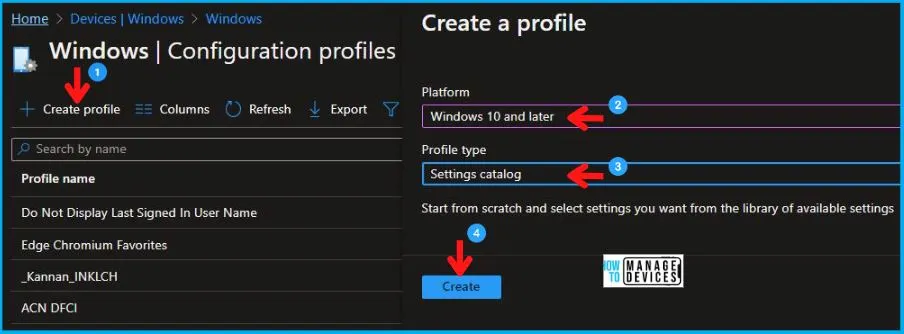
On the Basics tab pane, provide a name for the policy as “Audit PNP Activity Policy.” Optionally, you can enter a description for the policy, and then proceed by selecting “Next.
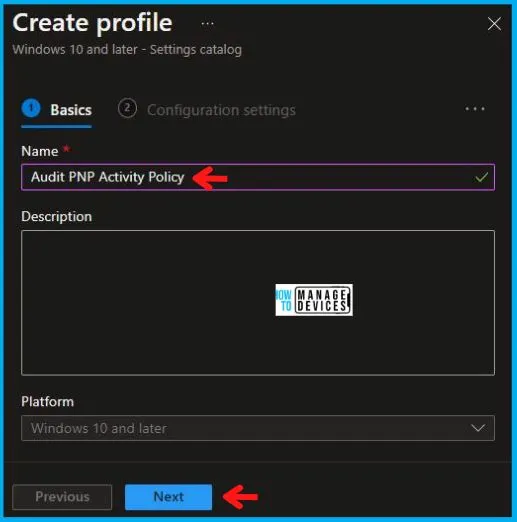
Now in Configuration settings, click Add Settings to browse or search the catalog for the settings you want to configure.
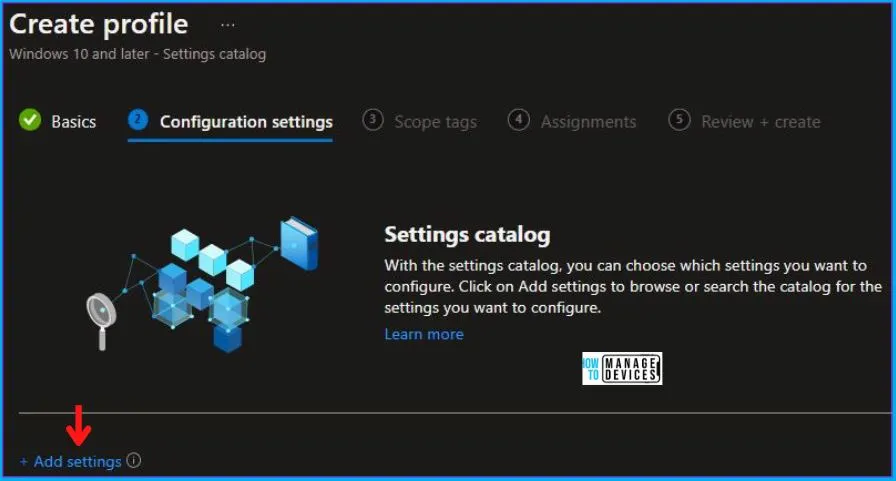
In the Settings Picker windows, search by the keyword PNP Activity, you will see only one setting, which is Auditing, and select this.
When you select the option as stated above, you will see only one option, which is Detailed Tracking Audit PNP Activity. After selecting your setting, click the cross mark at the right-hand corner, as shown below.
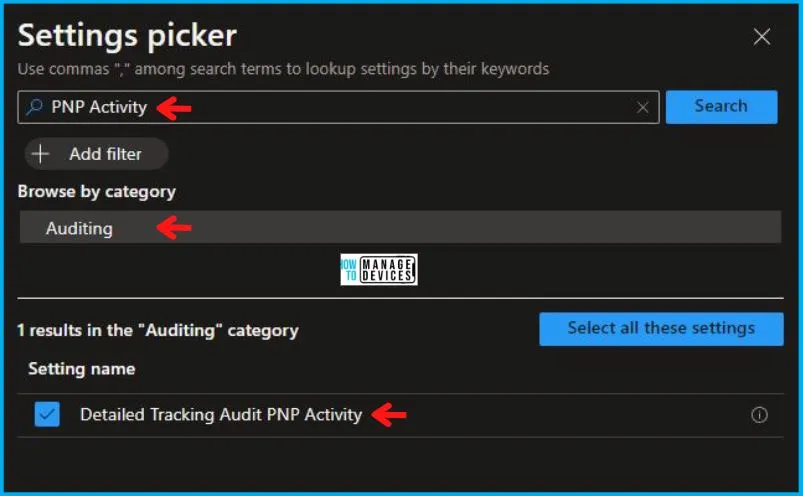
Now, in the Administrative Templates, set Detailed Tracking Audit PNP Activity to Success, as shown below in the image.
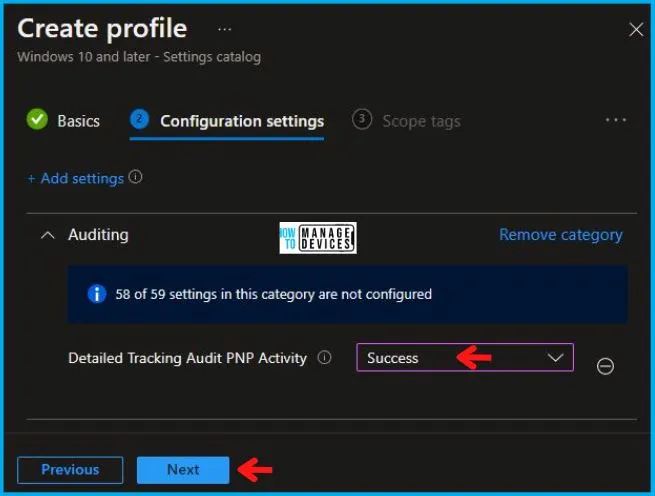
Using Scope tags, you can assign a tag to filter the profile to specific IT groups. One can add scope tags (if required) and click Next to continue. Now in Assignments, in Included Groups, you need to click on Add Groups, choose Select Groups to include one or more groups, and click Next to continue.
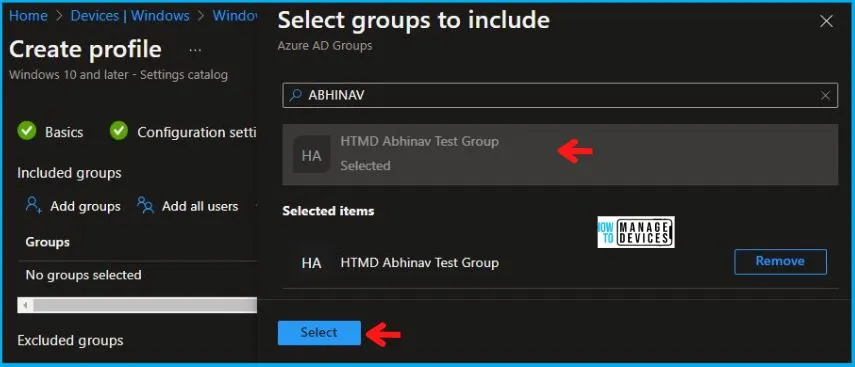
In the Review + Create tab, you need to review your settings. After clicking on Create, your changes are saved, and the profile is assigned.
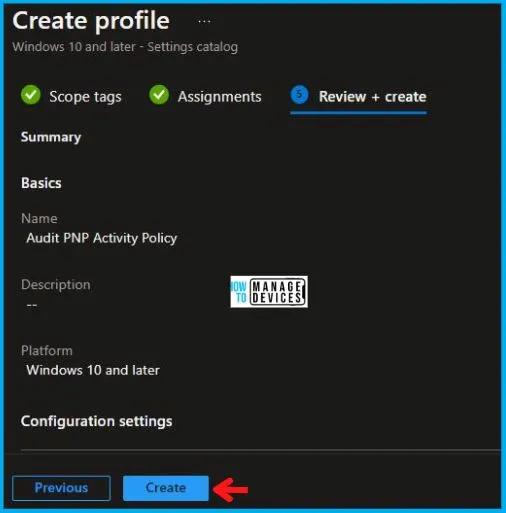
An automatic notification will be displayed in the top right-hand corner to indicate the successful creation of the “Audit PNP Activity Policy.“ Additionally, you can verify its presence by checking the Configuration Profiles list, where the policy will be clearly visible.
Your groups will receive your profile settings when the devices check in with the Intune service. The Policy applies to the device.
Intune Report for Audit PNP Activity Policy Using Intune
From Intune Portal, you can view the Intune settings catalog profile report, which provides an overview of device configuration policies and deployment status.
To monitor the assignment of the policy, you must choose the appropriate policy from the list of Configuration Profiles. You can check the device and user check-in status to see if the policy has been successfully applied. If you wish to view more information, you can click on “View Report” to see additional details.
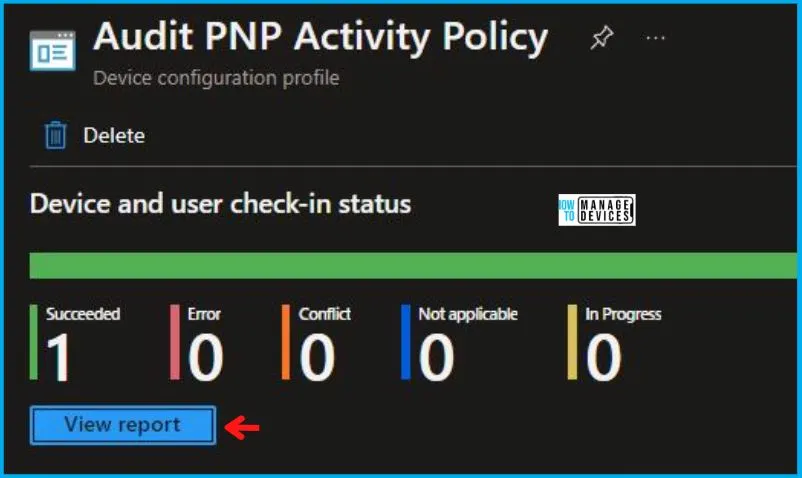
Intune MDM Event Log
To ascertain the successful application of String or integer policies on Windows 10 or 11 devices using Intune, event IDs 813 and 814 can be utilized. By analyzing these event IDs, you can identify both the policy’s application status and the specific value associated with the applied policy on those devices. For this specific policy, the value is an integer and is associated with event ID 813.
To confirm this, you can check the Event log path – Applications and Services Logs – Microsoft – Windows – Devicemanagement-Enterprise-Diagnostics-Provider – Admin.
MDM PolicyManager: Set policy int, Policy: (DetailedTracking_AuditPNPActivity), Area: (Audit), EnrollmentID requesting merge: (4009A089-4FBA-482B-9D17-9E5A8428CB98), Current User: (Device), Int: (0x1), Enrollment Type: (0xD), Scope: (0x0).
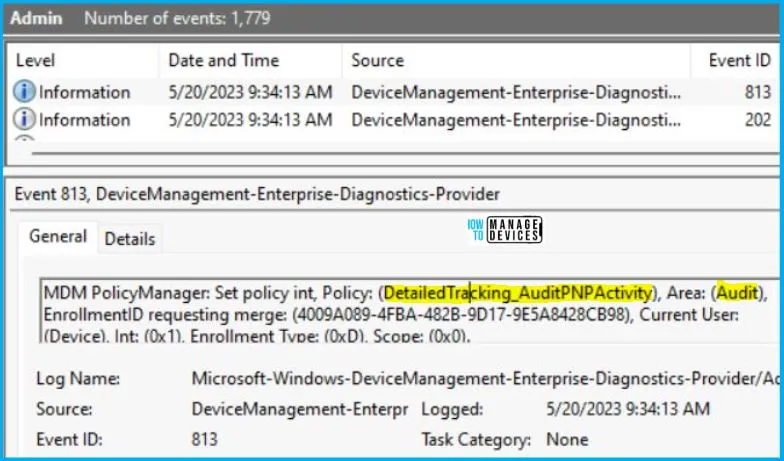
Upon examining the above-mentioned log in the Event Viewer, you will discover crucial details such as the Area and Enrollment ID. These pieces of information are instrumental in identifying the registry path. To find the relevant information, kindly refer to the table provided below:
| Area | Policy | Integer | Scoped | Event ID |
|---|---|---|---|---|
| Audit | DetailedTracking_AuditPNPActivity | Enabled | Device | 813 |
The information provided in the above table for Audit PNP Activity Policy Using Intune can be utilized to access the registry settings storing group policy configurations on a target computer. By running “REGEDIT.exe” on the target computer, you can navigate to the specific registry path where these settings are stored.
- Computer\HKEY_LOCAL_MACHINE\SOFTWARE\Microsoft\PolicyManager\providers\4009A089-4FBA-482B-9D17-9E5A8428CB98\default\Device\Audit
When you navigate to the above path in the Registry Editor, you will find the registry key with the name DetailedTracking_AuditPNPActivity. Refer to the table and image below.
| Registry Name | Value |
|---|---|
| DetailedTracking_AuditPNPActivity | 1 |

Author
Abhinav Rana is working as an SCCM Admin. He loves to help the community by sharing his knowledge. He is a B.Tech graduate in Information Technology.

